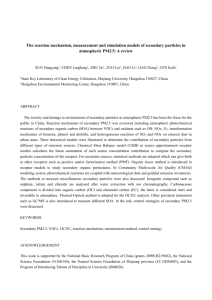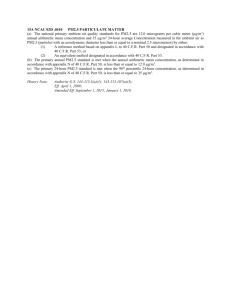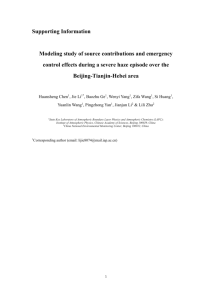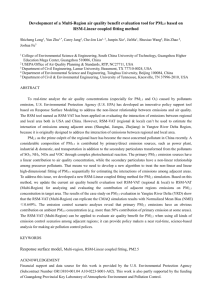PPT - Atmospheric Chemistry Modeling Group
advertisement
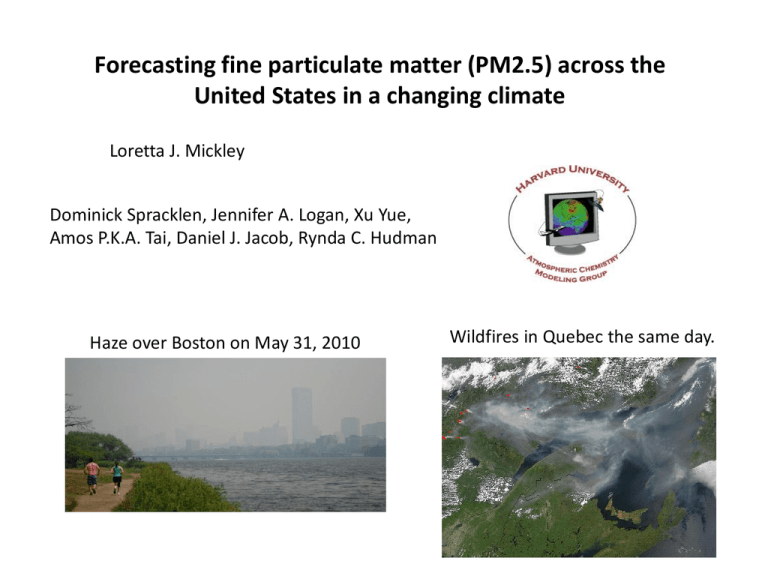
Forecasting fine particulate matter (PM2.5) across the United States in a changing climate Loretta J. Mickley Dominick Spracklen, Jennifer A. Logan, Xu Yue, Amos P.K.A. Tai, Daniel J. Jacob, Rynda C. Hudman Haze over Boston on May 31, 2010 Wildfires in Quebec the same day. Atmospheric chemistry examines the mix of gases and particles in the atmosphere: • Chemical reactions • Distributions in the atmosphere • Effects on climate and health • Effects of climate on smog Lifetimes in atmospheric chemistry Centuries: SF6, some CFCs Pollution over Hong Kong Decades: most greenhouse gases: CO2, N2O, . . . 9-10 years: CH4 (methane, precursor to ozone and greenhouse gas) Days-weeks: O3 (ozone), particulate matter (PM, aka aerosols) Seconds: OH, NO Air pollution over Hong Kong reached dangerous levels one of every eight days in 2009 2 Surface ozone and particulate matter are harmful to human health. Number of people living in areas that exceed the national ambient air quality standards (NAAQS) in 2008. Calculated with standard of 0.075 ppm. Proposed new standards will push more areas into non-attainment. Bars on barplot will change with changing emissions of ozone precursors. Climate change could also change the size of these bars, by changing the dayto-day weather. SO2 -- sulfur dioxide NOx -- nitrogen oxides Life cycle of particulate matter (PM, aerosols) precursor gases ultra-fine (<0.01 mm) nucleation Soup of chemical reactions VOCs -- volatile organic compounds NH3 -- ammonia fine (0.01-1 mm) . . coagulation . . . . condensation cloud (1-100 mm) cycling coarse scavenging (1-10 mm) SO2 NOx SO2 NOx VOCs combustion volcanoes NOx VOCs VOCs VOCs VOCs NH3 NOx NOx agriculture biosphere wildfires combustion soil dust sea salt 4 Climate change affects many processes. Life cycle of particulate matter (PM, aerosols) precursor gases ultra-fine (<0.01 mm) nucleation Soup of chemical reactions faster reactions SO2 NOx SO2 NOx VOCs combustion volcanoes fine (0.01-1 mm) . . coagulation . . . . condensation Warmer temperatures could increase some emissions. NOx VOCs VOCs cycling coarse scavenging (1-10 mm) VOCs VOCs NH3 cloud (1-100 mm) NOx NOx agriculture biosphere wildfires combustion soil dust sea salt 5 Transport also important! Life cycle of particulate matter (PM, aerosols) precursor gases ultra-fine (<0.01 mm) nucleation Soup of chemical reactions NOx SO2 NOx VOCs combustion volcanoes . . coagulation . . . . condensation evaporation Warmer temperatures push equilibrium toward gas phase. faster reactions SO2 fine (0.01-1 mm) NOx VOCs VOCs cycling coarse scavenging (1-10 mm) VOCs VOCs NH3 cloud (1-100 mm) NOx NOx agriculture biosphere wildfires combustion soil dust sea salt 6 Coming climate change will likely affect PM2.5 concentrations. Models disagree on the sign and the magnitude of the impacts Racherla and Adams, 2006 Response of sulfate PM2.5 at the surface to 2000-2050 climate change. • These model results are computationally expensive. A2 mg m-3 • How well do models capture variability in present-day PM2.5? Pye et al., 2009 We need a simple tool that will allow AQ managers to readily calculate the climate penalty for PM2.5 air quality across a range of models and scenarios. A1 mg m-3 7 Effects of wildfires on air quality in cities in Western US Hayman fire, June 8-22, 2002 56,000 ha burned 30 miles from Denver and Colorado Springs Worst ever air quality in Denver June 8, 2002 PM10 = 40 μg/m3 PM2.5 = 10 μg/m3 June 9, 2002 PM10 = 372 μg/m3 PM2.5 = 200 μg/m3 Standard = 35 µg/m3 Colorado Dept. of Public Health and Environment Vedal et al., 2006 Fires are increasing in North America obs temperature area burned 5 yr means 1960 Area burned in Canada has increased since the 1960s, correlated with temperature increase. Gillett et al., 2004 2000 Increased fire frequency over the western U.S. since 1970, related to warmer temperatures and earlier snow melt. 1970 2000 Westerling et al., 2007 Two constellations of studies 1. Sensitivity of PM2.5 to changing meteorology in the East. 2. Sensitivity of wildfires to changing climate in the West and the consequences for PM2.5. First, a few slides on chemistry + climate models. Basic working of climate models All climate models depend on basic physics to describe motions and thermodynamics of the atmosphere: E.g., vertical structure of pressure is described by hydrostatic equation P( z ) P( z dz ) a gdz dP a g dz Climate models also depend on parameterizations for many processes. E.g., microphysics of cloud droplet formation, vegetation processes. Input Tilt of earth, geography, greenhouse gas content Climate model Physics + Parameterized processes Output Weather + Climate 11 Simulations of future climate depend on the path of socio-economic development. Global mean surface temperature anomalies Different scenarios follow different socioeconomic paths for developed and developing countries. A2 = heavy fossil fuel B1 = alternative fuels A1B = mix of fossil + alternative fuels IPCC 2007 IPCC AR4 models show increasing temperatures across North America by 2100 in A1B scenario. Change in surface temperatures in 2100, relative to present-day. Results for precipitation changes are not so clear. IPCC, 2007 How 3-D chemistry models work. emissions transport dilution chemistry particulate matter (PM) and ozone pollution population GEOS-Chem chemical transport model: Global 3-D model describes the transport and chemical evolution of atmospheric pollutants winds Meteorology from a climate model Emissions + chemistry calculated within box Winds carry pollutants to other boxes. 14 Two constellations of studies 1. Sensitivity of PM2.5 to changing meteorology in the East. 2. Sensitivity of wildfires to changing climate in the West and the consequences for PM2.5. Surface ozone levels are sensitive to cold-front passage. Are particles also sensitive to cold-front passage? Leibensperger et al., 2008 Meteorology affects surface concentrations of PM2.5. Observed correlations of PM2.5 with meteorological variables. 1998-2008 meteorology + EPAAQS observations Multiple linear regression coefficients for total PM2.5 on meteorological variables. Units: μg m-3 D-1 (p-value < 0.05) Increases in total PM2.5 on a stagnant day vs. a nonstagnant day. Mean PM2.5 is 2.6 μg m-3 greater on a stagnant day Tai et al. 2010 17 2000-2050 climate change leads to increases in annual mean PM2.5 across much of the Eastern US. We used Principal Component Analysis to define the main meteorological modes driving PM2.5 variability over the US. Change in annual mean PM2.5 concentrations in 2050s relative to present-day 0.15 0.10 0.05 0.00 -0.05 -0.10 -0.15 mg m-3 Models show increased duration of stagnation in the East, with corresponding increases in annual mean PM2.5. This approach could provide a useful tool to assess climate penalty on PM2.5. We use observed relationships + climate models, no chemistry models. Tai et al., ms. How do we predict fires in a future climate? We don’t have a good mechanistic approach for modeling wildfires. Relationship between observed meteorology + area burned 1970 + Future meteorology 2000 Future area burned Predictions of area burned are made for large eco-regions for the fire season RMF ERM PNW NMS CCS DSW In each region, identify the meteorological variables that best predict area burned using stepwise linear regression. We find that the most important predictors for wildfires in the West are temperature, relative humidity, and precipitation. Ecoregions are aggregates of those in Bailey et al. (1994) Regression matches observed area burned, except for California coastal shrub Data Fit Fit depends on relative humidity the previous summer Spracklen et al., 2009; Yue et al., ms. GISS GCM meteorological output used to project future area burned, emissions and changes in air quality GISS climate model 1950 Spin-up 2000 Area Burned Regressions changing greenhouse gases (A1B scenario) 2025 2050 2075 2100 archive met fields from climate model GEOS-CHEM Predict Area Burned Calculate emissions Global chemistry model 50% increase in biomass consumption by wildfires over the western United States for 2045-2054, relative to present-day. Effect of future fires in a future climate on organic carbon in the western U.S. May-October change in OC Change in organic carbon (OC) by 2050s, relative to present-day (5 year mean) Organic carbon particles increase by 40% by 2050. Black carbon increases by 20%. For OC, most of increase is from fire emissions, some is from higher biogenic emissions in a warmer climate. Spracklen et al., JGR, 2009 Results shown so far were driven by one climate model. But models show large variation in response to changing greenhouse gases. Temp Results from IPCC AR4 ensemble of climate models: warmer, drier, less humid. Precip Changes in meteorology by 2050s, relative to present-day, for JJA RMF Rel Humidity PNW NMS CCS DSW ERM PNW, Pacific Northwest CCS, California Coastal Shrub DSW, Desert Southwest NMS, Nevada /Semi-desert RMF, Rocky Mountain Forest ERM, East Rockies/ Plains. Yue et al., ms. 1986-2000 2051-2065 +40% 1986 2065 Obs Wildfires in western US are predicted to increase by ~60% by 2050s. +20% Area burned (ha) Median of models spread of models doubling +60% The GCMs cannot match year to year variability, but match the mean area burned fairly well in present-day. RMF +70% ERM PNW NMS CCS DSW +60% Yue et al., ms. Forest Ratio of 2050s area burned / present-day area burned Forest Ratio of 2050s / present-day Median GCM results show an increase in area burned in all regions. median Median changes: 40-70% increase in forested regions 60% increase in grasslands Doubling in Southwest RMF ERM PNW NMS CCS DSW Yue et al., ms. Organic particles increase in future atmosphere over the western U.S. in summer, especially during extreme events. Change in OC in ~2050s, relative to present-day Cumulative probability of daily mean concentrations of organic particles 2050s doubling Presentday Rocky Mountains April-October. Yue et al., ms. How do we improve fire predictions in S. California? The largest fires in CA are associated with Santa Ana events. Fire plumes (Oct. 2007) Composite Santa Ana winds Need finely resolved wind fields to capture Santa Ana in meteorological record. Hughes and Hall (2010) Area burned Improving predictions of area burned in Southern California. Fire data from a suite of sources. Surface pressure anomalies Parameterize area burned as function of: • Temperature • Relative humidity • Precipitation • Large-scale pressure differences Divide up southern California into 3 smaller ecoregions. Yue et al., ms. Seasonality of fires in Southern California Fire regions South-West Cal. area num. fires Central Western Cal. Largest area burned in SW California. October peak associated with the Santa Ana winds, which are underestimated by large scale models as they lack the detailed topography: need large-scale approach Sierra Nevada New parameterization predicts yearly variability and seasonality in south west California Southwest CA R2=0.64 Seasonality Area burned in ~2050 / Present-day Area burned in Southern California increases 20-100% by 2050s relative to present-day. R P South west California R Central California R P Two approaches used in each ecoregion. Sierra Nevada Yue et al., ms. Conclusions Models show increased duration of stagnation in future atmosphere, with corresponding increases in annual mean PM2.5. Wildfire activity in the West can be predicted with meteorological variables. Area burned by wildfires may double in some regions in the western US by 2050s. By 2050s, mean summertime organic carbon particles could increase 40-70%, with doubling during extreme events. Future regional predictions for meteorology in A1B 2100 atmosphere show large variation across North America. Percent change in 2100 precipitation relative to present-day Annual DJF JJA Number of models showing increasing precipitation most models few models IPCC 2007
